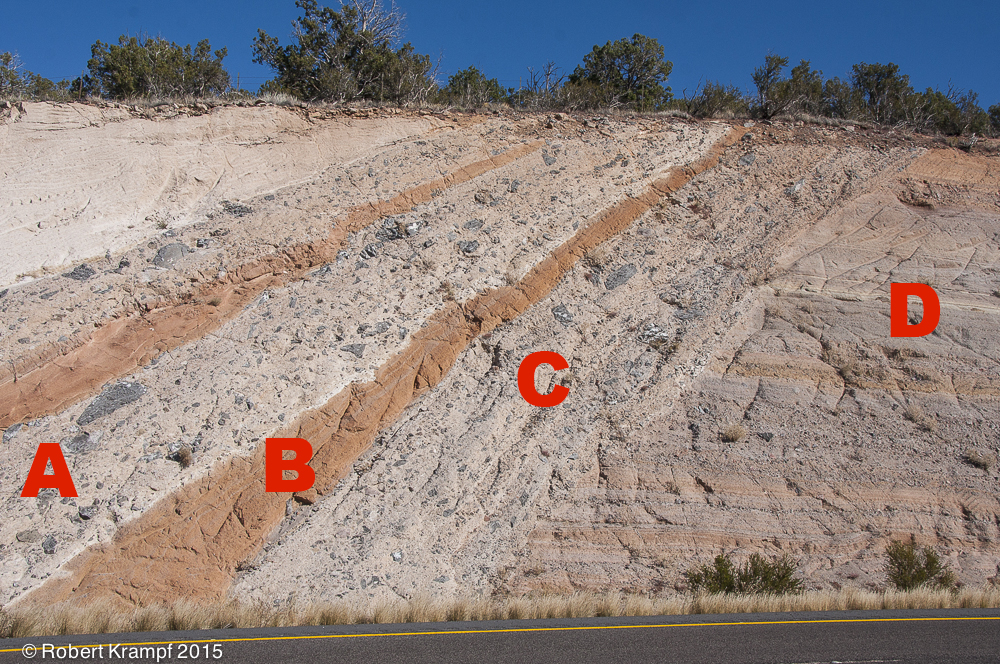
None of these layers have been turned upside down. Based on the Law of Superposition, which layer is the oldest?
-
A
No. Layer A is on top of layer B, so it is younger than layer B. That means that it is not the oldest. -
B
No. If you look at layer B, it is on top of layer C, which means that it is younger than layer C. B is not the oldest. -
C
No. Look closely at the top part of layer C. The top part of layer C is on top of part of layer D. That tells us that layer C is younger than layer D. -
D
Yes! This one is a bit tricky, because of the way the rocks were formed. Layer D formed first, as a flat, horizontal layer. Erosion weathered the left part of D away, forming a sloping hillside. Image the photo with layers A, B, and C erased, and it looks like a sloping hillside.Next, a nearby volcano erupted, spewing out lots of volcanic ash. The ash covered the hillside, forming layer C.
Next, lava from the volcano flowed down over the ash, forming layer B.
Later, the volcano erupted again, depositing another layer of volcanic ash to form layer A. After that, layer A was covered by another layer of lava, and then another layer of volcanic ash.
So A is the youngest, followed by B, then C, and D is the oldest.
Click to see which state standards this question tests, and which of my videos, experiments, and other resources support that topic.
Florida
SC.7.E.6.3 Identify current methods for measuring the age of Earth and its parts, including the law of superposition and radioactive dating.
| Imagining Geologic Time | video |
| Reading the Rocks: Law of Superposition | video |
| Reading the Rocks: Law of Crosscutting | video |
| Reading the Rocks | text page |
| Review Geologic Time-1 | practice |
| Review Geologic Time-2 | practice |
| Review Geologic Time-3 | practice |
Utah
UT.8.III.3.c Explain why some sedimentary rock layers may not always appear with youngest rock on top and older rocks below (i.e., folding, faulting).
| Sedimentary Rocks | video, learnalong |
| Review Geologic Time-1 | practice |
| Review Geologic Time-2 | practice |
| Review Geologic Time-3 | practice |
NGSS
4-ESS1-1 Identify evidence from patterns in rock formations and fossils in rock layers to support an explanation for changes in a landscape over time.
| Evaporites | video, learnalong, checked |
| Igneous Rocks and Bubbles | video, free, learnalong, Updated |
| Sedimentary Rocks | video, learnalong |
| Reading the Rocks: Law of Superposition | video |
| Reading the Rocks: Law of Crosscutting | video |
| What is a Rock? | video, learnalong, checked |
| Reading the Rocks: The Present is the Key to the Past | video, ClosedCaptions |
| Paleo Cookies | video |
| Homemade Fossil Dig | text page |
| Review Rocks-1 | practice |
| Review Geologic Time-1 | practice |
| Review Rocks-4 | practice |
| Review Geologic Time-2 | practice |
| Review Rocks-5 | practice |
| Review Rocks-6 | practice |
| Review Rocks-8 | practice |
| Review Rocks-9 | practice |
| Review Rocks-7 | practice |
| Review Rocks-10 | practice |
| Review Geologic Time-3 | practice |
